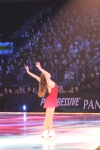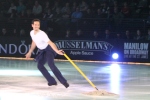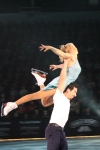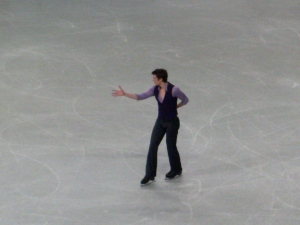Sports pundits in all disciplines love a good poll. Who wouldn’t want to vouch for their team or athlete’s success? It’s apparent from Icenetwork’s various polls that figure skating enthusiasts have been looking forward to Omaha 2013 for quite a while, and that most fans have a relatively clear idea of who will walk away with a gold–or at least silver–medal. Thanks to feature articles, the senior frontrunners now only have to start checking elements off the list, because the public is already convinced that they can, and will, bear the crown of U.S. National Champion.
Each of the four disciplines in Omaha will be infused with a special level of excitement when these high-profile skaters take the ice. It’s Nationals, after all. However, it’s almost more intriguing to watch the battle for bronze play out. Whose score will hold up for ten skaters? Who will have the skate of his life? Who will jump from prodigy junior medalist to stunning senior medalist? And who will make a costly error that negates any short program lead? The third- and fourth-place finishers have the opportunity to leap to glory at a moment’s notice if they get chosen for Worlds, yet the press often neglects them in the clamor surrounding the title holders.
The path to victory is never straightforward, and the dark horse competitors just might surprise us all.
Senior Ladies
The Hopefuls: Vanessa Lam, Caroline Zhang, Gracie Gold, Christina Gao
We Predict: Christina Gao. Although Zhang has previously medaled at the U.S. Championships and Gold has maturity beyond her years, Gao has a quiet consistency that could rocket her to the podium.
But You Never Know: Mirai Nagasu’s fluctuating international season means that no spot is guaranteed in the ladies’ event.
Updated placements: Gracie Gold (2nd), Christina Gao (5th), Mirai Nagasu (7th), Caroline Zhang (11th), Vanessa Lam (WD)
Senior Men
The Hopefuls: Max Aaron, Keegan Messing, Joshua Farris, Douglas Razzano
We Predict: Max Aaron. The quality of U.S. men’s figure skating is about to peak right before Sochi, as talented younger skaters get their feet under them, and Aaron is the epitome of this new generation. He’s fast, he has good flow on the ice, and he has the eponymous quadruple jumps.
But You Never Know: Jason Brown is always enjoyable to watch, and if his program is smartly constructed, he could post some serious numbers.
Updated placements: Max Aaron (1st), Joshua Farris (4th), Jason Brown (8th), Douglas Razzano (12th), Keegan Messing (16th)
Senior Pairs
The Hopefuls: Felicia Zhang/Nathan Bartholomay, Alexa Scimeca/Chris Knierim, Tiffany Vise/Don Baldwin
We Predict: Tiffany Vise/Don Baldwin. The low number of pairs entered in the event this year puts everyone on a more level field, but Vise/Baldwin have enough competitive experience to give them an advantage over newer teams who are still getting a feel for chemistry and coordination.
But You Never Know: Gretchen Donlan/Andrew Speroff have come a long way in the last three years, with improved strength and respectable results at other competitions.
Updated placements: Scimeca/Knierim (2nd), Zhang/Bartholomay (3rd), Donlan/Speroff (6th), Vise/Baldwin (10th)
Senior Dance
The Hopefuls: Madison Hubbell/Zachary Donohue, Madison Chock/Evan Bates, Lynn Kriengkrairut/Logan Giulietti-Schmitt
We Predict: Lynn Kriengkrairut/Logan Giuletti-Schmitt. Both Chock and Bates have achieved success with previous partners, but Lynn and Logan’s perseverance over the years is a strong indicator that they are ready to tackle the podium run together.
But You Never Know: Anastasia Cannuscio/Colin McManus. They are a team on the rise and, if they stay together in the coming years, could create some good results.
Updated placements: Chock/Bates (2nd), Hubbell/Donohue (4th), Kriengkrairut/Giulietti-Schmitt (5th), Cannuscio/McManus (6th)
Happy 2013 Nationals Viewing! You tell us: Who are your favorite “dark horses”? Whose skating impressed you the most?














